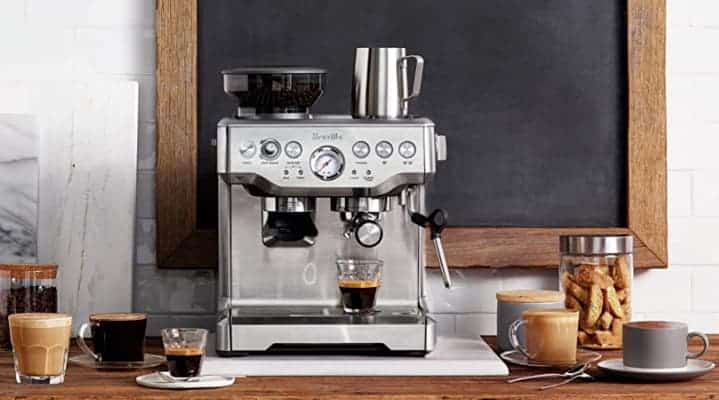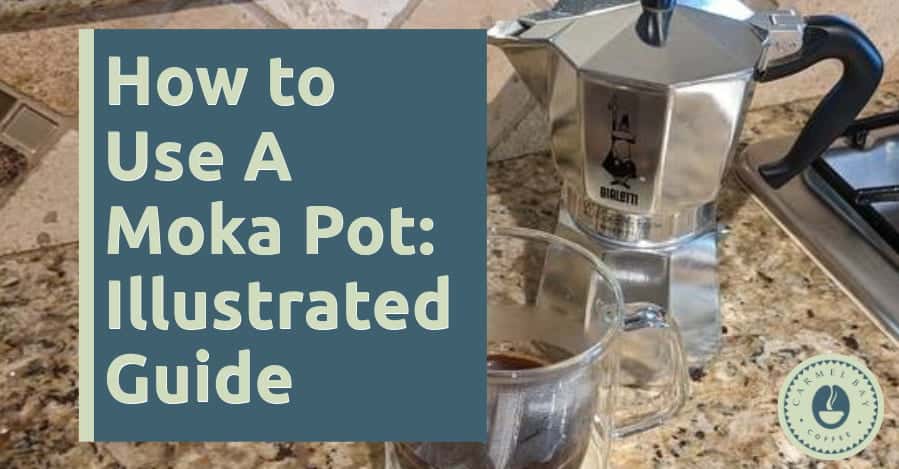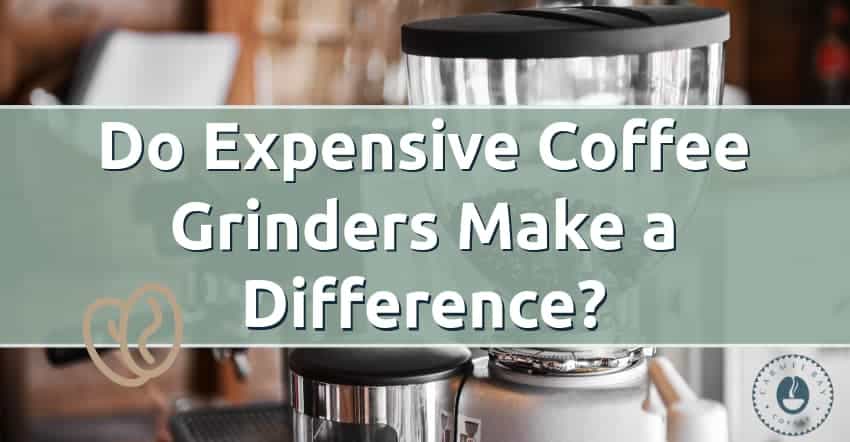If you are looking to make the perfect cup of espresso at home, it’s time to consider whether a pump or steam espresso maker is right for you. It all starts with the brewing process, and there are two main ways to brew an espresso: using a pump or using steam.
In this article, we will compare pump and steam espresso makers, discussing their individual benefits and drawbacks so that you can make an informed decision about which machine is best for you.
I encourage you to read my article, but if you’re looking for the best starter espresso machine you’ll find that an espresso machine with a pump is your best option. You can find our #1 recommendation right here.
Pump vs. Steam Espresso Machine
The main difference between the two brewing methods is how the water is forced through the coffee. In pump-based espresso makers, a rotary pump creates high pressure, typically around 9 atmospheric bars of pressure, to force water through the coffee grounds.
To get an understanding of bars.
Steam espresso machines brew coffee under pressure, only 1-2 bars (14 to 28 psi). This is not even close to what an espresso machine with a pump can produce. A pump-style espresso machine brews espresso with 8 to 10 bars (116 to 145 psi) of pressure.
That’s 5 to 10 times the pressure of a steam espresso machine, depending on the model.
In steam-based espresso makers, a heating element boils water, creating steam pressure to push water through the grounds.
To create a delicious espresso, a basic understanding of brewing time, water temperature, pressure, and grind size is necessary. Finding the right balance between these elements is both a form of art and science, and professional baristas dedicate countless hours to perfecting their espresso drinks.
With time, you’ll get the process down and make perfect espresso as well!
Without the proper equipment and knowledge, it can be challenging to achieve optimal coffee-making results. Let’s explore the contrast in the brewing process between pump and steam methods.
Difference in Brewing Process Between Pump Vs. Steam
The pump brewing process is typically seen in semi-automatic and automatic espresso machines, which use a group head to deliver hot and pressurized water from the machine, passing through a diffusion plate and finally into the basket containing the coffee grounds, known as a portafilter.
The pump applies consistent pressure to the water, leading to a consistent extraction of flavor from the coffee grounds. The water temperature and grind size are also carefully controlled to ensure the ideal brewing conditions.
n steam-based brewing, an internal boiler is used to heat and pressurize the water, which is then pushed through the coffee grounds, and then up and out into a container. While this method can produce a good espresso, it lacks the precision and control of a pump-based system.
The pressure and temperature of the steam can vary, leading to inconsistent results. Steam-based brewing is typically used in Moka pots, a popular type of stove-top or electric brewer, and entry-level espresso makers.
To learn more about how to use a Moka pot, check out our guide to Moka pots.
Pros & Cons: Pump Espresso Machines
Pump-based espresso machines come in various sizes, colors, and with different features. These stylish tools indicate to visitors of a kitchen that a coffee connoisseur is present.
Pump Espresso Machine Brewing Pros
One of the main advantages of pump-based brewing is consistency. The consistent pressure and temperature control, leading to a more consistent extraction of flavor from the coffee grounds. This results in a richer, bolder flavor, with a creamy crema on top.
Another advantage of pump-based brewing is the ease of use and maintenance. Many semi-automatic and automatic espresso machines come with programmable brewing options, making it easy to get the perfect cup of espresso every time.
Cleaning and maintenance are also relatively simple, with the group head and portafilter being the main components that need regular cleaning. More on maintenance and cleaning later.
On top of the consistency of the pump-based espresso machines is convenience. Most espresso machines come with everything needed. Including a hopper to hold and grind your beans, a water container, and a steam wand. This allows for baristas of all levels to make unique coffee drinks such as cappuccinos and lattes.
Finally, as mentioned above, the pump machine automatically regulates water temperature and pressure, taking the guessing game out of the picture.
Advanced models allow users the option of manually configuring and setting their desired temperature, grind size, and brew time.
Pump Espresso Machine Brewing Cons
One potential drawback of the pump brewing method may be in the machine itself, as opposed to the end result. For those living in small households or who prefer a peaceful morning, the pump machines can be a bit loud, which may be a problem.
To create the pressure desired for a true espresso shot of 9 atmospheric bars or higher, the pump has to compress water, and that can sound a bit like a small generator running in your kitchen.
However, machines with a rotary pump tend to be a bit quieter than espresso machines with a vibrating pump.
Overall I’ve had both, and I don’t think one or the other is that big of a deal; it’s just worth mentioning.
The main disadvantage of pump espresso machine is the cost. Semi-automatic and automatic espresso machines can be expensive, with some models costing several thousand dollars. Additionally, repairs and replacement parts can also be costly.
All that convenience and consistency comes at a price. We’ll talk more about cost below, but for now, let’s understand the pros and cons of steam-based brewing.
Pros & Cons: Steam Espresso Machines
I’m going to focus on a Moka pot when talking about “Steam Espresso Machines.” While there are steam espresso machines that look like pump machines, they are title junk, and really they are glorified Moka pots with plastic over them! To get an idea, here’s an example of a junk steam espresso machine.
If you’re price sensitive, just get a Moka pot. They last decades! I love mine and use it because it gives a unique taste some describe as “dirty espresso.” This is the Moka pot that I use.
There are a few different examples of steam espresso makers, they can be the perfect addition to small spaces or frequent travelers. While some models are electric others utilize a heat source such as the stovetop.
Steam Espresso Machine Brewing Pros
One of the main advantages of steam-based brewing is its affordability. Moka pots and entry-level espresso makers are relatively cheap, making them a great option for those on a budget. They are also relatively easy to use, with most models having simple brewing instructions. You can find out Moka pot guide here.
Another advantage of steam-based brewing is the ease of cleaning and maintenance. Moka pots and entry-level espresso makers have few moving parts, making them easy to clean and maintain.
Steam Espresso Machine Brewing Cons
However, the main disadvantage of steam-based brewing is the inconsistent pressure and temperature control, leading to inconsistent results.
The steam pressure can vary, leading to under or over-extraction of the coffee grounds.
The water temperature can also vary, leading to a lack of crema or a bitter taste.
Most steam brewers will only achieve 1 to 2 atmospheric bars of pressure. Equating the final brew to somewhere between a strong espresso and light drip coffee. Leaving the true connoisseur with a less-than-desired outcome.
Finally, steam brewers typically provide no way of making various coffee drinks without other tools in place. For instance, you would need a grinder, and a method for steaming milk in order to make a latte or cappuccino.
Pump Vs. Steam Espresso Maker Cost Comparison
In terms of cost, steam-based espresso makers are cheaper than pump-based espresso machines. Moka pots and entry-level espresso makers will cost under $100, while semi-automatic and automatic espresso machines can cost several hundred, to several thousand dollars.
Like many things in life, the cost of an automatic espresso machine is reflective of the features and quality of materials it offers.
Higher-end models come equipped with a hopper, which holds the coffee beans and often includes a built-in grinder. However, not all espresso machines have these features so be sure to check before purchasing.
- If you’re going for a Moka pot, this is the one I recommend.
- For an entry-level pump espresso maker, this is the one I recommend.
Tips For Using A Steam or Pump Brewer
- A rookie mistake: Allowing the steam brewer to heat the water and coffee at the same time. This will result in a more bitter flavor. A better method is to preheat the water in a kettle and pour that into the steamer before heating.
- Don’t over brew: When the steam brewer completes immediately take it over to the sink and run cool water on the bottom. This will quickly dissipate the steam and stop the brewing process from continuing
- Pack it in: With pump espresso machines you will pack the grind into the portafilter, tamping it down to make a solid puck. On the contrary, with steam brewing simply level it off.
Grind size matters: For pump machines, a fine grind is necessary to achieve a true espresso shot. However, for a steam brewer, a slightly less fine grind is used. For those who want to make the perfect cup of espresso, it is important to not only start with high-quality coffee beans but also to have a consistent grind.
A good grind can make all the difference, so it’s worth taking the time to learn more about Coffee Grinders.
Maintenance and Cleaning
Creating the perfect shot of espresso involves various factors such as bean quality, brew time, and equipment. However, cleanliness is often overlooked. Here are a few signs that indicate your machine may need cleaning:
- Slow extraction time for espresso.
- Unusual taste in espresso, such as burnt flavor.
- Inconsistent performance of the machine.
- Unusual noises during operation.
- Light indicators show it’s time to clean.
If you’re having trouble brewing espresso, a dirty machine may be the cause.
Do you know what creates the creamy, delicious crema on top of your espresso? The crema is produced by essential oils from coffee beans. While these oils contribute to the taste of our espresso, they can also cause buildup in our machines over time.
The essential oils from coffee beans can leave residues on the water screen, filter basket, and portafilter of a machine.
These residues can eventually create a film that clogs the filter basket holes and leaves gunk inside the portafilter spout.
If not cleaned, the oil residues can go rancid and affect the flavor of your espresso.
Aside from ensuring great flavor, proper maintenance of your machine can also extend its lifespan. An espresso machine is a significant investment, and taking care of it will ensure you can enjoy delicious espresso for years to come.
How Do You Clean a Pump Espresso Machine
Pump-based espresso machines have more moving parts but are relatively easy to clean and maintain, with regular cleaning of the group and portafilter you can be assured an even flow and consistent flavor.
Occasionally, you may need to descale your pump-based espresso machine by using a cleaning tab and running several non-coffee cycles through the portafilter.
It’s essential to clean the main parts after each use. Discard the coffee puck, rinse the parts, run the steam wand for a few seconds if it has one, and wipe the exterior with a clean towel.
Additionally, replace the water container filter as recommended by the manufacturer.
How Do You Clean a Steam Espresso Machine
As for a steam brewer, it’s as simple as giving it a good rinse after each use. Most brewers are machine washable and should be thoroughly cleaned as such on occasion.
Carmel Bay Coffee Pro Tip: The notion that leaving coffee residue in a steamer enhances the flavor of the next cup is a misconception. In reality, it can cause a bitter taste in the final product. Be sure to thoroughly rinse out your steamer after each use.
Finally, most Moka pot stream brewers have a rubber gasket seal to help maintain the pressure. Be sure to keep it rinsed off after each use and replace it if you notice any inconsistency in brewing.
Wrapping Up Pump Vs. Steam Espresso Makers
Choosing between a pump-based and steam-based espresso machine ultimately depends on personal preference and intended use. Pump-based machines offer more control and consistency in the brewing process, making them ideal for espresso enthusiasts and professionals.
Steam-based machines, on the other hand, are more affordable and simpler to operate, making them a great choice for casual coffee drinkers.
Both types of machines have their own unique benefits and limitations, so it’s essential to consider your needs and budget before making a decision. Whether you prefer a classic espresso or a cappuccino with creamy foam, either option can provide a satisfying coffee experience with the right technique and maintenance.
Check out our best tips for making the best coffee at home in our article, Easy Ways to Level Up Your Home Barista Game!





